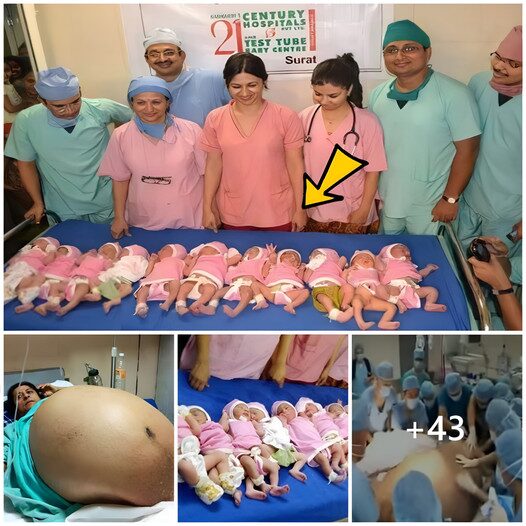According to a fascinating tale, an extraordinary mother in Surat, India, reportedly gave birth to eleven babies at once, including ten daughters and one son.
Yes, you read that correctly – eleven babies! But is this a verifiable fact or merely a product of urban legend and clever photo editing?
While the image in question seems to speak volumes (though we know images can be deceiving), anonymous sources claim that the photograph actually captures eleven babies born on the memorable date of November 11th, 2011 (11/11/11).
However, there’s a twist to the tale. Six of these babies were born as twins to the same mother. The other five were simply born on this unique date. There have been claims and calls to the Guinness Book of World Records to recognize this extraordinary event, with “unofficial sources” allegedly ready to provide further evidence of this incredible birth story.

As of now, no official news outlet has confirmed or debunked the claim of a woman giving birth to 11 children in a single pregnancy. So, let’s examine this medically and logically. Is it really feasible for a woman to carry and deliver 11 fetuses?
Multiple births can occur naturally, such as when a woman ovulates more than one egg per month, and all are fertilized, or when a single egg splits right after fertilization, creating multiple embryos. With the rise of fertility treatments like In Vitro fertilization, which involves implanting several fertilized eggs in the hope that at least one will develop, multiple births have become more common. Fertility drugs can also cause the release of multiple eggs, leading to the birth of multiple babies.
Then there’s the phenomenon of twins born months apart, another intriguing aspect of multiple births.
Sextuplets (six babies at once) are no longer a rarity. In fact, there are increasing instances of women giving birth to six healthy babies. But what about seven, eight, or more?
In 1997, the first medically documented case of surviving healthy septuplets occurred in the United States, consisting of three girls and four boys, with weights ranging from 3 lbs 4 oz to just 15 ounces.
And what about eight babies at once? In 1998, a set of octuplets was born in Houston, Texas. The first baby was delivered 15 weeks premature, with the rest following two weeks later via cesarean section. Tragically, the smallest of them passed away after a week, but the remaining seven survived and are thriving.
In another high-profile case, ‘Octomom’ Nadya Suleman, who has a total of 14 children, took to Instagram to wish a happy birthday to the eight children she welcomed via IVF in 2009. They are all growing up healthy and strong.
However, most reports of multiple births beyond octuplets do not have happy endings. In 1999, a Malaysian woman gave birth to nine babies, which were the most babies born in one birth at the time. Sadly, all the babies died within six hours of living.
The world record for a natural pregnancy is held by a woman in Argentina, who was pregnant with 12 embryos, but unfortunately, none were viable.
In 1971, a woman conceived no less than 15 babies and delivered them all, though not at once, with multiple Caesarean sections. Sadly, all of the babies also died after birth.
The sad truth is that pregnancies involving multiple babies often come with complicated medical issues in the long run. Even though the babies survive birth, many end up suffering from various problems related to their cramped conditions in the womb.
